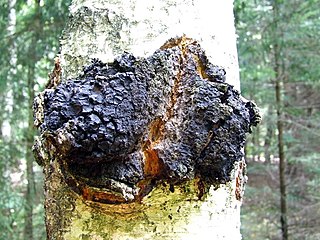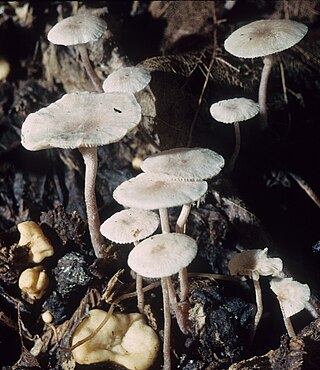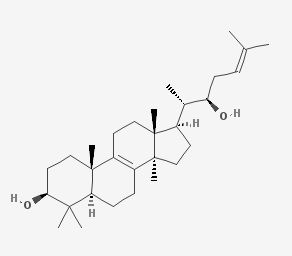
The Hymenochaetales are an order of fungi in the class Agaricomycetes. The order in its current sense is based on molecular research and not on any unifying morphological characteristics. According to one 2008 estimate, the Hymenochaetales contain around 600 species worldwide, mostly corticioid fungi and poroid fungi, but also including several clavarioid fungi and agarics. Species of economic importance include wood decay fungi in the genera Phellinus and Inonotus sensu lato, some of which may cause losses in forestry. Therapeutic properties are claimed for Inonotus obliquus ("chaga") and Phellinus linteus, both of which are now commercially marketed.

Betulin is an abundant, naturally occurring triterpene. It is commonly isolated from the bark of birch trees. It forms up to 30% of the dry weight of silver birch bark. It is also found in birch sap. Inonotus obliquus contains betulin.

Inonotus obliquus, commonly called chaga, is a fungus in the family Hymenochaetaceae. It is parasitic on birch and other trees. The sterile conk is irregularly formed and resembles burnt charcoal. It is not the fruiting body of the fungus, but a sclerotium or mass of mycelium, mostly black because of a great amount of melanin. Some people consider chaga medicinal.

Inonotus cuticularis is a species of fungus in the family Hymenochaetaceae. A plant pathogen, it has a circumpolar distribution, and is found in the temperate zone from eastern U.S. and Canada to Japan, China, Russia and south to central Europe.

Inonotus hispidus, commonly known as shaggy bracket, is a fungus and a plant pathogen. This fungus has been used in eastern Asia as a popular remedy for many illnesses like cancer, diabetes, and other stomach ailments. In modern pharmacology, it has aided in lowering blood glucose levels, showing anti-tumor responses and improving overall health in mice.

Thelocactus hastifer is a species of plant in the family Cactaceae. It is endemic to Mexico. Its natural habitat is hot deserts.

Meshimakobu and sanghuang / sanghwang, also known as mesima (English) or black hoof mushroom, is a mushroom in East Asia.

Inonotus is a genus of fungi in the family Hymenochaetaceae. The genus, described by Petter Karsten in 1879, is estimated to contain about 80 species sensu lato and 30 species sensu stricto.

Inonotus dryadeus, commonly known as oak bracket, warted oak polypore, weeping polypore or weeping conk, is an inedible species of fungus belonging to the genus Inonotus, which consists of bracket fungi with fibrous flesh. Most often found growing at the base of oak trees, it causes white rot and decay of the trunks. It secretes an amber liquid which weeps from tubes in its upper surface.

Collybia cookei is a species of fungus in the family Tricholomataceae, and one of three species in the genus Collybia. It is known from Europe, Asia, and North America. The fungus produces fruit bodies that usually grow on the decomposing remains of other mushrooms, like Meripilus giganteus, Inonotus hispidus, or species of Russula; occasionally fruit bodies are found on rich humus or well-decayed wood. The fungus produces small white mushrooms with caps up to 9 mm (0.35 in) in diameter, supported by thin stems that originate from a yellowish-brown sclerotium. The mushroom is difficult to distinguish from the other two species of Collybia unless an effort is made to examine the sclerotia, which is usually buried in the substrate. The edibility of the mushroom has not been determined.

Inonotus tamaricis is a species of fungus in the family Hymenochaetaceae. A plant pathogen, it grows on dead and living Tamarix species, and is found in Southern Europe, North Africa, Syria and Senegal, Southern Asia and east to China.

Inotodiol is an anti-inflammatory sterol isolated from Inonotus obliquus.

Triaxomera fulvimitrella, the four-spotted clothes moth, is a moth of the family Tineidae. It is found in most of Europe, except Ireland, the Iberian Peninsula, Italy, Slovenia and most of the Balkan Peninsula. The habitat consists of woodlands.

Inoscavin A is an antioxidant isolated from the mushroom Inonotus xeranticus.
Medicinal fungi are fungi that contain metabolites or can be induced to produce metabolites through biotechnology to develop prescription drugs. Compounds successfully developed into drugs or under research include antibiotics, anti-cancer drugs, cholesterol and ergosterol synthesis inhibitors, psychotropic drugs, immunosuppressants and fungicides.
Tropicoporus tropicalis is a mushroom of the family Hymenochaetaceae. Tropicoporus tropicalis is a wood-decaying basidiomycetes that rarely causes disease in animals and human, and is commonly found in humid climate such as Brazil. In its natural environment, the fungus is associated with white rot woody angiosperms, and has its annual fruiting body on tree trunks and branches. Tropicoporus tropicalis has two kinds of hyphae, generative and skeletal, that lack clamp connections.
Inonotus rigidus is a species of fungus in the family Hymenochaetaceae. It is distinguished by its resupinate and rigid basidiocarps, its yellow pore surface, being microscopically ellipsoid and yellowish brown, its thick-walled basidiospores, and by lacking both setal hyphae and hymenial setae.
Inonotus chrysomarginatus is a species of fungus in the family Hymenochaetaceae. It is distinguished by having an annual to perennial growth habit, pileate basidiocarps, setal hyphae and hooked hymenial setae, and subglobose, yellowish, thick-walled cyanophilous basidiospores.

Inocutis is a genus of nine species of polypore fungi in the family Hymenochaetaceae.
Onthophagus hastifer, is a species of dung beetle found in India, Sri Lanka, Vietnam, Taiwan, Thailand, and Myanmar.













